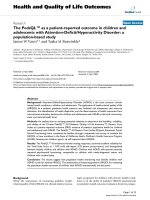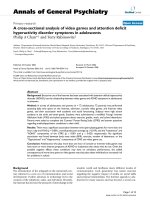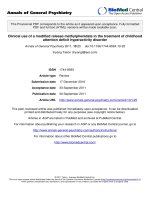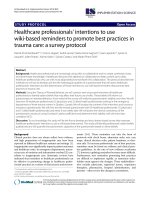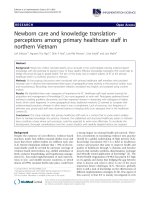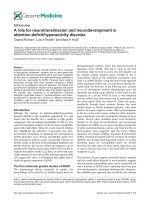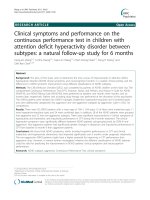Guideline use among different healthcare professionals in diagnosing attention deficit hyperactivity disorder in Dutch children; who cares
Bạn đang xem bản rút gọn của tài liệu. Xem và tải ngay bản đầy đủ của tài liệu tại đây (848.57 KB, 8 trang )
Levelink et al. BMC Psychology
(2019) 7:43
/>
RESEARCH ARTICLE
Open Access
Guideline use among different healthcare
professionals in diagnosing attention deficit
hyperactivity disorder in Dutch children;
who cares?
Birgit Levelink1* , Lonneke Walraven1, Edward Dompeling1, Frans J. M. Feron2 and
Dorothea M. C. B. van Zeben-van der Aa1
Abstract
Objective: Current data about Attention Deficit Hyperactivity Deficiency (ADHD) guideline use in the Netherlands
are absent. This study analysed ADHD guideline use among different healthcare workers, and the use of key
elements from these guidelines to diagnose ADHD.
Method: A survey assessing ADHD guideline use was distributed throughout the Netherlands to various health care
professionals. Only professionals involved during the diagnostic process were included.
Results: Response rate among GPs was low (111/1450), but high among other health care professionals (251/287).
A total of 362 surveys were analysed, 186 responders (51%) were involved during the diagnostic process. Overall
guideline use was 64.5%; the national multidisciplinary guideline or a guideline made by a professional’s own
institution were most used. Psychiatrists, psychologists and paediatricians reported compliance with key elements
of the guidelines such as gathering information from a third party (> 90%) and carrying out a developmental
history (> 88%). Use of a standardized interview (< 52% often use) was low. Only paediatricians performed a
physical examination regularly (88%).
Conclusion: Despite low general use of guidelines, psychiatrists, psychologists and paediatricians use similar key
elements of ADHD guidelines. This study provides opportunities to improve care through increasing familiarity with
ADHD guidelines and the use of standardized interviews.
Keywords: ADHD, Guidelines, Diagnosis, Children
Introduction
Attention-Deficit Hyperactive Disorder (ADHD) is a
neurodevelopmental disorder, affecting people of all ages
with an onset in childhood. According to the most recent meta-analyses, worldwide prevalence in children
and adolescents is estimated between 3.4 and 7.2% [28,
29, 39]. Although no increase in the worldwide prevalence of ADHD was found in the past ten years, in 2014
the need for (health) care in relation to symptoms of attention deficit and/or hyperactivity and impulsivity in
* Correspondence:
1
Department of Paediatrics, Maastricht University Medical Centre (MUMC+),
PO Box 5800, 6202 AZ Maastricht, The Netherlands
Full list of author information is available at the end of the article
the Netherlands showed a 30 % increase over the previous decade [11, 15, 16]. Recent studies provided several
explanations, such as increased awareness of ADHD
among health care professionals, parents and teachers,
increased academic research on the disorder, and better
accessibility to (health) care [5, 14, 16, 32]. Little is
known about the care pathways of Dutch children with
problems of attention deficit and/or hyperactivity, and
the use of, and compliance with ADHD guidelines by
different healthcare professionals. It is important to
know how an ADHD diagnosis ADHD is made, as deviation from recommendations may lead to undetected
comorbid conditions, misdiagnosis and unnecessary use
of tests. ADHD is a complex diagnosis in which both
© The Author(s). 2019 Open Access This article is distributed under the terms of the Creative Commons Attribution 4.0
International License ( which permits unrestricted use, distribution, and
reproduction in any medium, provided you give appropriate credit to the original author(s) and the source, provide a link to
the Creative Commons license, and indicate if changes were made. The Creative Commons Public Domain Dedication waiver
( applies to the data made available in this article, unless otherwise stated.
Levelink et al. BMC Psychology
(2019) 7:43
genetic and environmental factors play an important role
[37]. During the diagnostic process it is important to assess that, due to symptoms of attention deficit and / or
hyperactivity and impulsivity, the child experiences limitations in his or her functioning [3]. Correct interpretation of behavioral characteristics requires sufficient
knowledge about the disorder. Worldwide research between 1995 and 2016 showed a lack of knowledge about
ADHD and a shortage of enthusiasm among GPs to get
involved in ADHD care. [10, 18, 20, 21, 33, 34, 36]. Epstein et al. [9] concluded that part of community-based
American paediatricians did not act according to
evidence-based guidelines [9]. As in many other countries, ADHD is diagnosed in the Netherlands by various
healthcare professionals, such as general practitioners
(GPs), psychologists, child & youth psychiatrists and pediatricians [6, 35, 38, 42]. Over time, several Dutch
ADHD guidelines were published to standardize and improve diagnosis and treatment. In 2005 a multidisciplinary guideline was published which has many similarities
with the guideline commissioned by the British National
Institute for Health and Clinical Excellence [22, 26].
Since 2014 guidelines for GPs, youth care and primary
youth health care have been issued, which gave the opportunity to diagnose and treat symptoms of ADHD in
consultation with specialists [4, 40].
To gain more insight into the increase of (health) care
use in the Netherlands due to ADHD symptoms, it is
important to know whether important elements of an
ADHD diagnosis are sufficiently taken into account by
(health) care professionals to avoid misdiagnosis. For example, consideration should be given to the presence of
ADHD behavior in different settings. In addition, it is
useful to know if problems are adequately detected in
primary health care. The first step is to gain insight into
the use of the existing guidelines by different (health)
care professionals, and to evaluate if these guidelines are
applied correctly. The objective of this study was therefore 1) to describe the use of different ADHD guidelines
among healthcare professionals for children in the
Netherlands and 2) to determine whether diagnosing
ADHD is in accordance with key elements of these
guidelines.
Methods
Study design and setting
This cross-sectional study was conducted between
March 2017 and August 2017 at the paediatric department of the Maastricht University Medical Centre. A
survey was designed using the online questionnaire platform Qualtrics [30]. A wide variety of healthcare professionals may be involved in ADHD care, but exact data
was not available. Therefore, all known institutions for
ADHD care in the Netherlands were identified through
Page 2 of 8
searches on the Internet, to then evaluate whether they
were involved in ADHD diagnostics. The targeted professional groups included paediatricians, child and youth
psychiatrists, psychologists, GPs, general practice-based
nurse specialists and youth health care physicians
(school doctors). The Dutch ADHD Network distributed
the survey directly to health care professionals affiliated
with the network. In total 36 psychologists, 27 child and
youth psychiatrists, 48 paediatricians and 13 youth
health care physicians were directly addressed by the
ADHD network, and 128 institutions for child mental
health, 10 hospitals and 25 primary health services were
approached. Among individual general practitioners it
was difficult to determine if ADHD care was provided.
GPs are organized per province in groups, and email addresses for individual GPs were requested from the presidents of these GP groups. Two provinces released this
data, and therefore a sample of 1450 GPs was addressed.
Measurement
A 27-question survey based on the different Dutch
guidelines was developed, focusing on elements used
during the diagnostic process. The first part of the survey consisted of 4 questions assessing involvement of
the individual healthcare professional during the diagnostic phase of ADHD. Respondents not belonging to
the target group were excluded after finishing this part.
The following 16 questions related to the use of guidelines in general and evaluated the practice patterns with
regard to an ADHD diagnosis. Survey items assessed adherence to five diagnostic key elements specified in the
Dutch multidisciplinary guideline, the Dutch guideline
for GPs and the youth healthcare guideline (Table 1).
Questions about diagnostic instruments and (re)
screening too1ls were tailored to the Dutch situation.
Questionnaires advised by different guidelines and askes
for in the survey were: 1. ‘ADHD Vragenlijst’ [AVL, The
Dutch ADHD Questionnaire], a Dutch behavioural questionnaire for children aged 4 to 18 years that is based on
the Conners’ Rating Scale for ADHD [41]. 2. The Child
Behavior Checklist (CBCL) and the Teacher’s Report
Form (TRF), both components of the Achenbach System
of Empirically Based Assessment (ASEBA) [1] (Achenbach, 1991). 3.The Strengths and Difficulties Questionnaire (SDQ), a brief behavioural screening instrument
[13]. Use of The Conners’ Rating Scale (CRS), a behavioural questionnaire designed to assess symptoms of
ADHD, originally developed by C. Keith Conners in
1969 and revised in 1997, was added as an extra option.
To gather the intended information multiple choice
questions and 3-point and 5-point Likert-type scale measured responses were mainly used. For some questions
an open text field was included automatically when the
answer “otherwise” was chosen. A paediatrician, a
Levelink et al. BMC Psychology
(2019) 7:43
Table 1 Dutch guideline recommendations; diagnostic key
elements from the guidelines that are asked for during the
survey
Evaluation of attention deficit, hyperactivity and impulsivity symptoms.
Advised by all guidelines.
Specifically asked were the use of semi-structured interviews, options:
semi-structured interview with parents (Anxiety Disorders in Interview
Schedule for DSM-IV (ADIS), Children's Aggression Scale (CAS), Kiddie
Schedule for Affective Disorders and Schizophrenia for school aged children (K-SADS), Kiddie Disruptive Behavior Disorders Schedule (K-DBDS),
Parental Account of Children's Symptoms (PACS), Parent Interview for
Child Symptoms (PICS-4-dutch version), Semi-structured Clinical Interview for Children and Adolescents (SCICA)).
Gathering information from somebody else than the parents and/or
child.
Advised by all guidelines.
Specifically asked how information is gathered; questionnaires, semistructured interview or direct observation.
Use of questionnaires.
Advised by the Dutch multidisciplinary guideline: Child Behavior
Checklist (CBCL), Youth Self Report (YSR) and Teacher report Form (TRF).
Advised by youth health care: Strengths and Difficulties Questionnaire
(SDQ), ADHD Questionnaire (ADHD vragenlijst AVL).
Other possibilities;
CRS, Conner’s Rating Scale, Questionnaire for behavioural problems in
children (Vragenlijst voor Gedragsproblemen bij Kinderen, VvGK)
Knowledge of developmental history, family history and physical
condition.
Advised by all guidelines.
Additional examination only advised on indication.
Only advised on indication by all guidelines.
Specifically asked: Complete neuropsychological testing, Intelligent
Quotient test (IQ), didactic test, Electrocardiogram (ECG), laboratory tests.
research worker and GP from the University of Maastricht were asked to pilot test the questionnaire, whereupon its applicability was improved for primary as well
as secondary health care professionals.
The last 7 questions assessed the characteristics of the
health care professionals, like gender, age, work experience and experience with diagnosing ADHD in children.
A question about the location of the institution was included to determine geographic diversity.
Analysis
Responses were converted to IBM SPSS Statistics version 22 for Mac for further analysis [19]. First, univariate
descriptive statistics were used to assess frequencies of
responses by demographic variables. To determine
guideline use in general and per profession Pearson chi
square tests was used. This test was also applied to analyse the use of important guideline elements. For each
guideline component, reported response ‘often’ or ‘always’ was contrasted with reported response ‘never’,
‘rarely’ or ‘sometimes’. Because numbers of respondents
per professional were low, and varied between subgroups, subgroup analyses were not possible. Finally,
univariate logistic regression was used to analyse if the
use of a standardised approved national guideline led to
Page 3 of 8
more adherence to key elements of the guidelines than
the use of a protocol of the own institution or any other
protocol. Professionals who responded to having used
the approved Dutch multidisciplinary guideline, the GP
guideline or the youth health care guideline were
marked as using a standardised guideline. They were
compared with professionals who responded to having
used a protocol from their own institute or a protocol
made by themselves.
Results
Characteristics of respondents
Response rate of GPs was low; 111 of the 1450 surveys returned. In contrast, the response rate of other
health care professionals was high; 251 of 287 surveys
were returned. In total 362 questionnaires were
returned (Fig. 1). Only 186 professionals responded
that they were actually involved during the diagnostic
process of ADHD, 176 professionals referred children
with symptoms of ADHD to another care professional. In particular youth health care physicians (45/
50), GPs (98/111) and paediatricians (22/40) were excluded in the first part of the survey because they referred children when they suspected ADHD, and
evaluated that additional diagnostics were necessary.
166 professionals completed the whole survey. Characteristics of professionals involved during the diagnostic process are shown in Table 2. The majority
was female (84.3%). Most of the respondents evaluated less than 25 new patients per year (57.8%); especially pediatricians indicated that they had more than
100 consultations per year because of problems related to ADHD (41.2%). With the exception of GPs,
respondents were equally distributed over the
Netherlands.
Guideline use
The majority of professionals used some kind of guideline (64.4%). Of respondents who indicated that they did
not use a guideline, 18.3% used their own protocol, and
17.2% used no protocol at all. Table 3 shows the use of
guidelines by the four major response groups, i.e. child
& youth psychiatrists, psychologists, paediatricians and
GPs and the use of key elements from these guidelines.
Psychiatrists used guidelines most frequently (81.8%).
Standardized interviews, recommended in the official
guidelines, were used by less than 52% of all professionals. Most used interviews were the Anxiety Disorders in Interview Schedule for DSM-IV (ADIS) and the
Parent Interview for Child Symptoms (PICS-4-NL).
Gathering information from a third party (e.g. school)
was done by all disciplines. Information from a third
party was gathered by observation (40%), standardized
interviews (23%) and by questionnaires (34%). Although
Levelink et al. BMC Psychology
(2019) 7:43
Page 4 of 8
Fig. 1 Response rate and included professionals
Table 2 Characteristics of health care professionals involved
during the diagnostic process
Number of respondents N (%)
Profession (n = 186)
Child & youth psychiatrist
23 (12)
Psychologist
101 (54)
Paediatrician
18 (10)
General practitioner
13 (7)
Youth health care physician
5 (3)
Remedial teacher
17 (9)
Other
9 (5)
Sex (n = 166)
Female
140 (84)
Age in years (n = 166)
20–35
65 (39)
36–55
74 (45)
56>
27 (16)
Number of new patients per year (n = 166)
0–25
96 (58)
25–100
53 (32)
> 100
17 (10)
only recommended on indication in all guidelines, the
majority of respondents performed an IQ test (70.5%).
Only paediatricians performed physical examination
regularly (88.3%). Comparison of the group using an approved standardized Dutch guideline with the group
using a protocol from the own institute or made by the
(health) care professional showed two significant differences (Table 4). Professionals who used an official Dutch
guideline more often used a semi-structured interview
(OR 2.1; 95% CI 1.1–3.7), and they were more likely to
perform a physical examination (OR 2.6; 95% CI 1.1–
5.9).
Discussion
As data about ADHD guideline use in the Netherlands
was lacking, this study analysed ADHD guideline use
among different healthcare workers, and the use of key
elements from these guidelines to diagnose ADHD. The
use of national approved Dutch guidelines was low, but
was in accordance with the results of studies in other
countries [7, 8, 31, 44]. Many of the responding professionals commented to have a protocol of their own institute based on the national guidelines. These institution
protocols probably have many similarities with the national approved guidelines; the overall use of important
Levelink et al. BMC Psychology
(2019) 7:43
Page 5 of 8
Table 3 Use of Dutch guidelines and diagnostic key elements from guidelines per healthcare professional
Dutch diagnostic guideline recommendations
Overall adherence
(%; N = 169)
C&Y psychiatrists
(%; N = 19)
Psychologists
(%; N = 93)
Paediatricians
(%; N = 17)
GPs
(%; N = 13)
p value
General Guideline use
64.4
81.8
60.8
73.7
50.0
0.05
38.6
72.2
33.3
50.0
14.3
Guidelines used:
Multidisciplinary guideline
Youth healthcare guideline
11.4
0
14.0
14.3
0
GP guideline
6.1
0
0
0
71.4
Protocol own institution
39.5
27.8
Not specified
49.1
21.4
0
3.6
14.3
14.3
Evaluation of ADHD symptomsa
Use of semi structured interview
51.7
68.2
49.5
63.2
50.0
0.09
Gathering information from third partya
92,8
94.7
97.8
94.1
50.0
< 0.001
40.8
63.2
39.8
41.7
TRF
53.8
73.7
59.1
64.7
SDQa
49,1
42,1
51.6
41.7
11.8
AVL
66.3
73.7
71.0
70.6
23.1
CR-scalec
5.3
21.1
4.3
0
Developmental history
89.2
100
96.7
88.2
16.7
Perform physical examination
19.2
10.5
7.6
88.3
25,0
neuropsychological tests
62.7
73.3
56.5
70.6
91.7
IQ tests
29,5
10,5
19.6
41.2
100
Electrocardiogram
100
100
100
100
100
Laboratory tests
100
100
100
100
100
Use of questionnairesa
CBCLc
c
a
0.001
0.04
Additional knowledgea
< 0.001
< 0.001
Additional examination usedb
0.25
< 0.001
a
use often or always
b
use never or rarely on occasion
c
Use of this instrument was not asked in version of questionnaire for GPs and youth health care physicians
C&Y psychiatrist Child and Youth psychiatrist, GPs General Practitioners, AVL ADHD Vragenlijst (Dutch ADHD Questionnaire), CBCL Child Behavior Checklist, TRF
Teacher’s Report Form, SDQ Strengths and Difficulties Questionnaire, CRS Connor’s Rating Scale, IQ Intelligence Quotient
diagnostic key elements, like gathering information from
a third party and performing a developmental history
was high, both in accordance with the different national
guidelines. The only significant difference between the
group using an approved national guideline and the
group using an institution protocol was the use of a
semi-structured interview and performing a physical
examination. The more positive response on the question concerning physical examination in the group using
a national approved guideline was not simply explained
by the use of this approved guideline. Paediatricians
were the only professionals who responded to perform
regular physical examinations. All other professionals
hardly used a physical examination as part of the diagnostic process. Physical problems, like visual and hearing
impairment may mimic ADHD, and ADHD can also be
part of a physical disease like neurofibromatosis. Children with ADHD often have somatic comorbidities like
enuresis, making physical examination an important part
of the diagnostic process [2, 12, 17, 25]. It seems necessary to reaffirm the importance of the physical examination to several professionals.
There were some striking features. Overall use of
semi-structured interviews was low. ADHD is a best
practice diagnosis, but diagnostic clinical structured interviews showed high values for sensitivity and specificity in relation to the comprehensive best practice
diagnosis [27]. Low use of structured interviews may either lead to inaccurate diagnosis or undetected comorbidities. The heterogeneity of obtaining information
Levelink et al. BMC Psychology
(2019) 7:43
Page 6 of 8
Table 4 Likelihood of using key elements when using a Dutch
national approved ADHD guideline (instead of a protocol made
by the own institution or a protocol made by the healthcare
professional)
Odds ratio
95% CI
Use of semi structured interview
2.1
1.1–3.7
Gathering information from a third party
1.7
0.5–5.7
CBCL
0.9
0.5–1.8
SDQ
1.6
0.9–2.9
AVL
Use of questionnaires
0.6
0.3–1.2
Use of developmental history
1.6
0.6–4.2
Perform physical examination
2.6
1.1–5.9
Neuropsychological tests
0.8
0.5–1.6
IQ tests
0.7
0.4–1.5
Use of additional examination
CI Confidence Interval, CBCL Child Behavior Checklist, SDQ Strengths and
Difficulties Questionnaire, AVL ADHD Vragenlijst (Dutch ADHD Questionnaire),
IQ Intelligence Quotient
regarding symptoms of inattention and hyperactivity
from third parties and the high use of IQ tests and
neuropsychological tests, by psychologists, C&Y psychiatrists and paediatricians was also remarkable. It is possible that our respondents evaluated a selected patient
population with high comorbidity rates, requiring a tailored child-focused program, with more need for additional tests. However, part of these additional IQ and
neurological tests may have been unnecessary, and
therefore increased costs for ADHD care.
Currently various healthcare professionals in the
Netherlands diagnose ADHD. Despite the introduction
of several ADHD guidelines for primary healthcare
workers, the majority of GPs and youth health care
workers indicated to refer children with ADHD symptoms to other professionals. The National Health Statistics Report of the United States of America showed a
high involvement of paediatricians; in their study almost
40% of the parents were told by a paediatrician that their
child had ADHD [23, 42]. Many paediatricians in the
Netherlands indicated not to be involved when it comes
to diagnosing ADHD. Mental health care workers, in
particular child psychologists and psychiatrists, were
most involved during the diagnostic process. This study
was conducted after the transformation of youth care in
2015 in The Netherlands, which might explain low involvement of paediatricians [24]. The transformation
changed the financing system; municipalities instead of
healthcare insurances became responsible for ADHD
care both in terms of contents and finance. After the
transformation, only hospitals with an arrangement with
the municipalities were allowed to deliver ADHD care,
and many paediatricians decided not to provide care to
children with problems related to ADHD any longer. In
this study, 50% of the responding paediatricians indicated themselves to be specialized in ADHD care, which
corresponded with the large amount of children they
said to evaluate every year. An explanation for this could
be that municipalities particularly contracted paediatricians with large practices after the transformation of
youth care. This could also explain the relatively high
use of additional tests; these large practices are often
highly specialized and therefore see children with complex problems.
This transformation of youth care was part of the new
Child and Youth Act, which formed the basics of a plan
of action made by all professionals involved in the care
for children with (symptoms of ) ADHD in 2015 [24].
The three major principles of this Child and Youth Act
were: to make more use of ‘own strength’ and the social
network of children and their parents; to allow children
to participate as much as possible by normalizing,
unburdening and not unnecessarily medicalize, and: to
reduce specialised health care by using more primary
care [43]. The number of included GPs in the study was
low, maybe because they were only involved in ADHD
care for children since 2014. Most GPs referred children
directly after presenting with symptoms of ADHD or
when they suspected co-morbidity. Due to the low number of GPs, no conclusions could be drawn for this
group. It is important to do more research on the involvement of GPs in the care for children with ADHD,
as making use of primary care professionals is an important principle of the new Child and Youth Act.
This study has several limitations. It was impossible to
include professionals randomly by inviting the targeted
group, because no exact data of professionals involved in
ADHD care in the Netherlands was available. This has
created various risks for selection bias. First, it is not
clear whether a good reflection of care providers has received the questionnaire. Second, respondent bias was
possible due to self-selection of the respondents; most
likely professionals who felt involved in ADHD care
completed the survey. Another limitation was the low
number of some professionals. Response rate in the GP
group was extremely low and the number of GPs involved in ADHD care even lower. As a result, no conclusions could be made concerning ADHD care by GPs. As
opposed to all other professionals who were located all
over the Netherlands, GPs from only two provinces
could be approached. These provinces were representative for a part of the Netherlands, but not for provinces
were the major cities are located. Finally the survey focussed on the diagnostic process and did not include
treatment (both pharmacological and non pharmacological). It was a deliberate choice to exclude professionals who were not involved in the diagnostic process
Levelink et al. BMC Psychology
(2019) 7:43
at the beginning of the survey. This was to prevent
people who were not involved in ADHD diagnostics
from completing the questionnaire and thus influencing
the results negatively. Retrospectively, it would have
been interesting to know whether the group that was excluded at the beginning of the questionnaire was involved in the treatment of ADHD. According to the
guidelines, ADHD symptoms must be regularly evaluated during treatment, to determine to what extent
ADHD symptoms still lead to dysfunction. In order to
evaluate ADHD symptoms properly, sufficient knowledge about the disorder is essential; the question is
whether this knowledge is sufficient if you do not participate in diagnosing ADHD. Further research is necessary to gain insight in the knowledge of professionals
who only treat children with ADHD.
Clinical implications
ADHD is a best-practice diagnosis. This was a quantitative
study and no statements can be made about the quality of
the ADHD diagnosis made by individual health care professionals or the possible impact on the increased demand
for ADHD care. However, practice variations were identified which generated new hypotheses. Involvement of
(relatively cheap) primary care was low. Response rate
from the GPs was very low. The Dutch government wants
a prominent role for GPs in the diagnostic process of
ADHD so it is important to conduct more research on the
involvement and knowledge of ADHD in this group.
Use of (expensive) additional testing was high, which
may be linked to easy access to these resources, different
demands of the referred patient group or low use of nationwide guidelines. Implications of these patterns cannot
be derived from this study but are of interest for further
investigation, especially directed to proper use of additional (neuro) psychological testing. Finally, more attention should be paid to the use of standardized interviews,
for example by incorporating them in new guidelines.
Conclusions
Various health care professionals, working in primary,
secondary and tertiary care, diagnose ADHD in children
in the Netherlands differently. In particular mental
health care workers and specialized pediatricians are involved in the diagnostic process. A slight majority is
using a nationwide guideline or a protocol of the professional’s own institution based on national approved
guidelines. Adherence to guidelines differs per health
care profession, but the use of diagnostic key elements,
like use of information from a third party and a developmental history, is high among professionals with the
highest response rate. Use of semi-structured interviews
and physical examination is low, raising opportunities
for improvement.
Page 7 of 8
Acknowledgements
The authors want to thank all professionals who have completed the
questionnaire and thereby made this research possible.
Funding
The authors received no financial support.
Availability of data and materials
If desired, all data and the questionnaire used can be assessed in
consultation with the corresponding author.
Authors’ contributions
BL, LW, DvZ participated in the design of the study and devellop the survey.
BL and LW performed the statistical analysis of the study. All authors were
involved in the interpretation of the results and all authors read and
approved the final manuscript.
Ethics approval and consent to participate
For this study no patients’ data were used. Participants were professionals,
who were given a choice to respond. It was made clear to participants that
answers would be used anonymously for research purposes. A response to
the survey was seen as informed consent. We did not use patient material,
and we blinded all questionnaires so no ethical committee was involved.
Consent for publication
Not applicable.
Competing interests
No potential competing interests with respect to the research, authorship,
and/or publication of this article.
Author details
1
Department of Paediatrics, Maastricht University Medical Centre (MUMC+),
PO Box 5800, 6202 AZ Maastricht, The Netherlands. 2Department of Social
Medicine, Care and Public Health Institute (CAPHRI), Maastricht University,
Maastricht, The Netherlands.
Received: 27 August 2018 Accepted: 22 April 2019
References
1. Achenbach M, Rescorla L. Manual for the ASEBA school age forms &
profiles. An integrated system of multi-informant assessment: University of
Vermont; 2001.
2. Adesman AR, Altshuler LA, Lipkin PH, Walco GA. Otitis media in children
with learning disabilities and in children with attention deficit disorder with
hyperactivity. Pediatrics. 1990;85:442–6.
3. American Psychiatric Association (APA). Diagnostic and Statistical Manual of
Mental Disorders, Fifth Edition (DSM-5). Arlington: American Psychiatric
Publishing; 2013.
4. Boer F, van de Glind G. Trimbos Instituut. In: JGZ-richtlijn ADHD; Signalering,
begeleiding en toeleiding naar diagnostiek [Youth Health Care guideline
ADHD: signalling, guiding and leading towards diagnosis]; 2015. Retrieved
from />5. Buitelaar JK. Discussies over aandacht tekort-hyperactiviteitstoornis (ADHD):
feiten, meningen en emoties [Discussion about attention deficit hyperactive
disorder (ADHD): facts, opinions and emotions]. Nederlands Tijdschrift voor
Geneeskunde. 2001;145:1485–9.
6. Canadian Attention Deficit Hyperactivity Disorder Resource Alliance.
Canadian ADHD practice guidelines (CAP-Guidelines). Third ed. Toronto:
CADDRA; 2010.
7. Chan E, Hopkins MR, Perrin JM, Herrerias C, Homer CJ. Diagnostic practices
for attention deficit hyperactivity disorder: a national survey of primary care
physicians. Ambulatory Pediatrics. 2005;5:201–8.
8. Efron D, Sciberras E, Hiscock H, Jongeling B, Lycett K, Bisset M, Smith G. The
diagnosis of attention-deficit/hyperactivity disorder in Australian children:
Current pediatric practice and parent perspective. Journal of Paediatrics and
Child Health. 2016;52:410–06.
9. Epstein JN, Kelleher KJ, Baum R, Brinkman WB, Peugh J, Gardner W,
Lichtenstein P, Langberg J. Variability in ADHD care in community-based
pediatrics. Pediatrics. 2014;134:1136–43.
Levelink et al. BMC Psychology
(2019) 7:43
10. Ghanizadeh A, Zarei N. Are GPs adequately equipped with the knowledge
for educating and counselling of families with ADHD children? BMC Fam
Pract. 2010;11:5 />11. Gijsen R, Nugteren R. Jaarprevalentie van ADHD-achtige symptomen in de
huisartsenregistratie, 2014 [Year prevalence of ADHD-like symptoms in
general practice registration, 2014]. Bilthoven: Rijksinstituut voor
Volksgezondheid en Milieu; 2016. Retrieved from https://www.
volksgezondheidenzorg.info/onderwerp/adhd/cijfers-context/trends#nodetrend-prevalentie-adhd-achtige-symptomen-huisartsenpraktijk
12. Gontard A, Equit M. Comorbidity of ADHD and incontinence in children.
European Child and Adolescent Psychiatry. 2015;24:127–40.
13. Goodman R. The strengths and difficulties questionnaire; A research note.
Journal of child psychology and psychiatry. 1997;38:581–6.
14. Graaf de R, Ten Have MM, van Dorsselaer S. De psychische gezondheid van
de Nederlandse bevolking. NEMESIS-2: Opzet en eerste resultaten [The
mental health of the Dutch population. NEMESIS-2: Design and first results].
Utrecht: Trimbos-instituut; 2010.
15. Health Council The Netherlands. Diagnostiek en behandeling van ADHD
[Diagnosis and treatment of ADHD]: Den Haag; 2000. Retrieved from
/>diagnostiek-en-behandeling-van-adhd.
16. Health Council The Netherlands. ADHD: medicatie en maatschappij [ADHD:
medication and society]: Den Haag; 2014. Retrieved from https://www.
gezondheidsraad.nl/documenten/adviezen/2014/07/03/adhd-medicatie-enmaatschappij.
17. Heuvel van den E, Starreveld JS, Ru de M, Krauwer V, Versteegh FGA.
Somatic and psychiatric co-morbidity in children with attention deficit
hyperactivity disorder. Acta Paediatrica. 2007;96:450–6.
18. Hirfanoğlu T, Soysal AS, Gücüyener K, Cansu A, Serdaroğlu A. A study of
perceptions, attitudes, and level of knowledge among paediatricians towards
attention-deficit/hyperactivity disorder. Turkisch J Pediatr. 2008;50:160–6.
19. IBM Corp. IBM SPSS Statistics for Mac OSX, version 22.0. Armonk: IBM
Corp; 2013.
20. Jawaid A, Zafar AM, Naveed A, Sheikh S, Waheed S, Zafar MA, Syed EU,
Fatmi Z. Knowledge of primary paediatric care providers regarding
attention deficit hyperactivity disorder and learning disorder: a study from
Pakistan. Singapore Medical Journal. 2008;49:985–93.
21. Kwasman A, Tinsley BJ, Lepper HS. Paediatricians’ knowledge and attitudes
concerning diagnosis and treatment of attention deficit and hyperactivity
disorders. A national survey approach. Archives Pediatrics Adolescent
Medicine. 1995;149:1211–6.
22. Landelijke Stuurgroep Multidisciplinaire Richtlijnontwikkeling.
Multidisciplinaire Richtlijn voor diagnostiek en behandeling van ADHD bij
kinderen en jeugdigen [Multidisciplinary Guideline for diagnosis and
management of ADHD in children and adolescents]. Utrecht: TrimbosInstituut; 2005. Retrieved from />Richtlijnenoverzicht/Details/tabid/1558/articleType/ArticleView/articleId/702/
ADHD-bij-kinderen-en-jeugdigen-diagnostiek-en-behandeling-van.aspx
23. McElligott JT, Lemay JR, O’Brien ES, Roland VA, Basco WT Jr, Roberts JR.
Practice patterns and guideline adherence in the management of attention
deficit/hyperactivity disorder. Clinical Pediatrics. 2014;53:960–6.
24. Ministerie Volksgezondheid, Welzijn en Sport [Ministry of Health and Sports]
(2014) Factsheet Stelselwijziging Jeugd, Jeugdwet [Change in Youth Care
Law]. />25. Muskens JB, Vermeulen K, Deurzen van PAM, Tomesen EMA, van der Gaag RJ,
Buitelaar JK, Staal WG. Somatische screening in kinder- en jeugd- psychiatrie:
een descriptieve pilotstudie [Somatic screening and child- and adolescent
psychiatry: a descriptive pilot study]. Tijdschrift voor psychiatrie. 2015;57:710–8.
26. National Collaborating Centre for Mental Health, National Institute for
Health and Clinical Excellence. Diagnosis and management of ADHD in
children, young people and adults – National Clinical Practice Guideline
Number 72. Leicester and London: The British Psychological Society and
The Royal College of Psychiatrists; 2009.
27. Parker A, Corkum P. ADHD Diagnosis: As simple as administering a
questionnaire or a complex diagnostic process? Journal of Attention
Disorders. 2016;20:478–86.
28. Polanczyk G, De Lima MS, Horta BL, Biederman J, Rohde LA. The worldwide
prevalence of ADHD: a systematic review and metaregression analysis. The
American Journal of Psychiatry. 2007;164:942–8.
29. Polanczyk GV, Salum GA, Sugaya LS, Caye A, Rohde LA. Annual research
review: A meta-analysis of the worldwide prevalence of mental disorders in
Page 8 of 8
30.
31.
32.
33.
34.
35.
36.
37.
38.
39.
40.
41.
42.
43.
44.
children and adolescents. Journal of Child Psychology and Psychiatry. 2015;
56:345–65.
Qualtrics. Retrieves from />qualtrics/.
Rushton JL, Fant KE, Clark SJ. Use of practice guidelines in the primary care
of children with attention-deficit/hyperactivity disorder. Pediatrics. 2004;114:
e23–8.
Sayal K, Prasad D, Daley V, Ford S, Coghill D. ADHD in children and young
people: prevalence, care pathways and service provision. Lancet Psychiatry.
2018;5:175–86.
Shaw K, Wagner I, Eastwood H, Mitchell G. A qualitative study of Australian
GPs' attitudes and practices in the diagnosis and management of attentiondeficit/hyperactivity disorder (ADHD). Family Practice. 2003;20:129–34.
Stein RE, Storfer-Isser A, Kerker BD, Garner A, Szilagyi M, Hoagwood KE,
O'Connor KG, McCue Horwitz S. Beyond ADHD: How well are we doing?
Academic Pediatrics. 2016;16:115–21.
Subcommittee on Attention-Deficit/Hyperactivity Disorder, Steering
Committee on Quality and Management. ADHD: Clinical practice guideline
for the diagnosis, evaluation, and treatment of Attention-Deficit/
Hyperactivity Disorder in children and adolescents. Pediatrics. 2011;128:
1007–22.
Tatlow-Golden M, Prihodova L, Gavin B, Cullen W, McNicholas F. What do
general practitioners know about ADHD? Attitudes and knowledge among
first-contact gatekeepers: systematic narrative review. BMC Family Practice.
2016;17:129.
Thapar A, Cooper M. Attention Deficit Hyperactivity Disorder. The Lancet.
2016;387:1240–50.
The Royal Australasian College of Physicians. Australian guidelines on
Attention Deficit Hyperactivity Disorder (ADHD). Sydney: RACP; 2009.
Retrieved from />Thomas R, Sanders S, Doust J, Beller E, Glasziou P. Prevalence of attentiondeficit/hyperactivity disorder: a systematic review and meta-analysis.
Pediatrics. 2015;135:e994–e1001.
Van Avendonk MJP. NHG-Standaard ADHD bij kinderen [Dutch General
Medicine Standard ADHD in children]. Huisarts Wetenschap. 2014;57:584–94.
Van der Ploeg JD, Scholte EM. ADHD-kinderen in ontwikkeling. Diagnostiek
en effectieve behandeling in de jeugdzorg [ADHD- children in
development. Diagnostics and effective treatment in youth care]. Utrecht:
Uitgeverij De Graaff; 2001.
Visser SN, Zablotsky B, Holbrook JR, Danielson ML, Bitsko RH. Diagnostic
experiences of children with attention-deficit/hyperactivity disorder.
National Health Statistics Report. 2015;81:1–7.
Werkgroep ‘gepaste zorg voor kinderen met aandachttekort en/of
hyperactiviteit en impulsiviteit’ [Taskforce ‘appropriate care for children with
inattention and/or hyperactivity and impulsivity] 2015. aad.
nl/nieuws-en-achtergronden/plan-van-aanpak-gepaste-zorg-bij-kenmerkenvan-adhd-gelanceerd.
Wolraich ML, Bard DE, Stein MT, Rushton JL, O’Connor KG. Pediatricians'
attitudes and practices on ADHD before and after the development of
ADHD pediatric practice guidelines. Journal of Attention Disorders. 2010;13:
563–72.
Publisher’s Note
Springer Nature remains neutral with regard to jurisdictional claims in
published maps and institutional affiliations.

